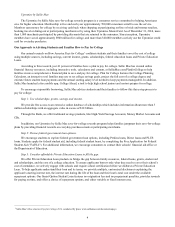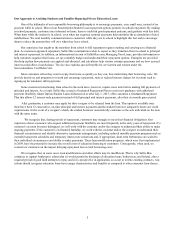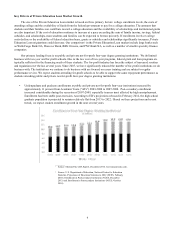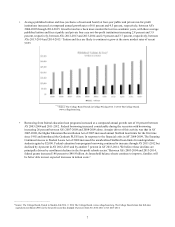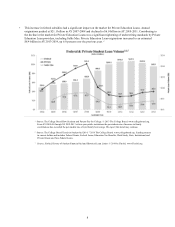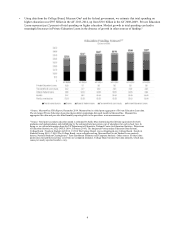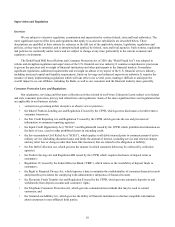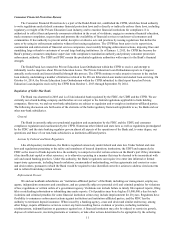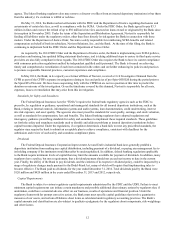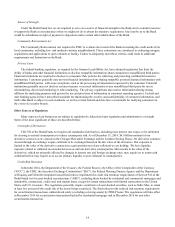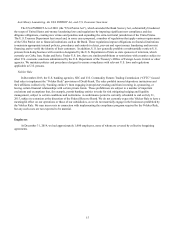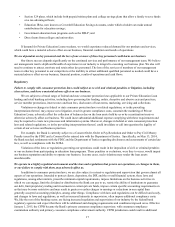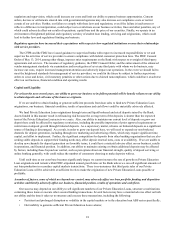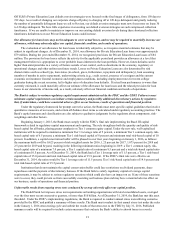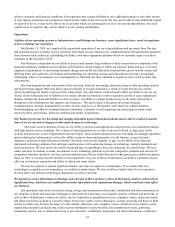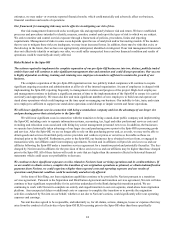Sallie Mae 2014 Annual Report Download - page 16
Download and view the complete annual report
Please find page 16 of the 2014 Sallie Mae annual report below. You can navigate through the pages in the report by either clicking on the pages listed below, or by using the keyword search tool below to find specific information within the annual report.Source of Strength
Under the Dodd-Frank Act, we are required to serve as a source of financial strength to the Bank and to commit resources
to support the Bank in circumstances when we might not do so absent the statutory requirement. Any loan by us to the Bank
would be subordinate in right of payment to depositors and to certain other indebtedness of the Bank.
Community Reinvestment Act
The Community Reinvestment Act requires the FDIC to evaluate the record of the Bank in meeting the credit needs of its
local community, including low- and moderate-income neighborhoods. These evaluations are considered in evaluating mergers,
acquisitions and applications to open a branch or facility. Failure to adequately meet these criteria could result in additional
requirements and limitations on the Bank.
Privacy Laws
The federal banking regulators, as required by the Gramm-Leach-Bliley Act, have adopted regulations that limit the
ability of banks and other financial institutions to disclose nonpublic information about consumers to nonaffiliated third parties.
Financial institutions are required to disclose to consumers their policies for collecting and protecting confidential customer
information. Customers generally may prevent financial institutions from sharing nonpublic personal financial information with
nonaffiliated third parties, with some exceptions, such as the processing of transactions requested by the consumer. Financial
institutions generally may not disclose certain consumer or account information to any nonaffiliated third party for use in
telemarketing, direct mail marketing or other marketing. The privacy regulations also restrict information sharing among
affiliates for marketing purposes and govern the use and provision of information to consumer reporting agencies. Federal and
state banking agencies have prescribed standards for maintaining the security and confidentiality of consumer information, and
Sallie Mae Bank is subject to such standards, as well as certain federal and state laws or standards for notifying consumers in
the event of a security breach.
Other Sources of Regulation
Many aspects of our businesses are subject to regulation by federal and state regulation and administrative oversight.
Some of the most significant of these are described below.
Oversight of Derivatives
Title VII of the Dodd-Frank Act requires all standardized derivatives, including most interest rate swaps, to be submitted
for clearing to central counterparties to reduce counterparty risk. As of December 31, 2014, $4.0 billion notional of our
derivative contracts were cleared on the Chicago Mercantile Exchange and the London Clearing House. All derivative contracts
cleared through an exchange require collateral to be exchanged based on the fair value of the derivative. Our exposure is
limited to the value of the derivative contracts in a gain position net of any collateral we are holding. We have liquidity
exposure related to collateral movements between us and our derivative counterparties. Movements in the value of the
derivatives, which are primarily affected by changes in interest rate and foreign exchange rates, may require us to return cash
collateral held or may require us to access primary liquidity to post collateral to counterparties.
Credit Risk Retention
In October 2014, the Department of the Treasury, the Federal Reserve, the Office of the Comptroller of the Currency
(“OCC”), the FDIC, the Securities Exchange Commission (“SEC”), the Federal Housing Finance Agency and the Department
of Housing and Urban Development issued final rules to implement the credit risk retention requirements of Section 941 of the
Dodd-Frank Act for asset-backed securitizations (“ABS”), including those backed by residential and commercial mortgages and
automobile, commercial, credit card, and student loans, except for certain transactions with limited connections to the United
States and U.S. investors. The regulations generally require securitizers of asset-backed securities, such as Sallie Mae, to retain
at least five percent of the credit risk of the assets being securitized. The final rules provide reduced risk retention requirements
for securitization transactions collateralized solely (excluding servicing assets) by FFELP loans. The regulations will take effect
in December 2015 for securitization transactions backed by residential mortgages and in December 2016 for any other
securitization transaction.
14


